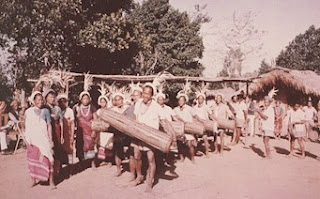http://en.wikipedia.org/wiki/Garo_(tribe)
http://westgarohills.nic.in/people.htm
The Garos are a tribe in Meghalaya and neighboring ares of Bangladesh. Most Garos are now Christians. The Garos are one of the few remaining matrilineal societies in the world. The individuals take their clan titles from their mothers. Traditionally, the youngest daughter (nokmechik) inherits the property from her mother. Sons leave the parents' house at puberty, and are trained in the village bachelor dormitory (nokpante). After getting married, the man lives in his wife's house. Garos are only a matrilinear society, but not matriarchal. While property of Garos are owned by the women, the men folk govern the society and domestic affairs and manages the property.In Garo customs it is the girls who propose a match to boys.
The staple cereal food is rice.Garos are very liberal in their food habits. They rear goats, pigs, fowls, ducks etc. and relish their meat.The common and regular festivals are those connected with agricultural operations.
2. Lushai:
http://en.wikipedia.org/wiki/Lusei
http://www.india9.com/i9show/Lushai-Tribe-22453.htm
http://www.indiahotelreview.com/state-mizoram.htm
The Lusei (Old Mizo: Lushai) people are one of the eleven clans of Mizo tribe, native to Mizoram in Northeast India.The Lusei people are usually described as "short, sturdy and heavy people of Mongolian type." The average height of men was usually between 162 cm and 170 cm. The average women's height ranged from 140 cm to 160 cm. Their skin complexion varied between dark brown to light yellow.Infant morality is seen high among this tribe.
Lushais build their house using bamboo and wood. The region being mostly of hilly nature, the houses are usually built on slopes. Wooden posts of different lengths are employed to provide the necessary support and balance. These posts are enforced with cross beams.The community members engage in the collection and gathering of forest products. For additional income, they make a variety of bamboo baskets and are sold in the market. Paikawng, Emsin, Paiem, Tlamen, Dawrawn and Fawng baskets are some fine specimens depicting the craftsmanship of the tribe.
Their tribe, also known as Mizo, in Kalemyo Sagaing division, western Burma is keen on contesting the forthcoming 2010 general elections for a seat in Parliament. They are now busy undertaking a census of community members. In the early nineteenth century the Lushai Tribe had a quarrel with the British. It was in the year 1895. British captured the province. When India developed into an independent country in 1947,the Mizo Hills were a part of Assam. In the year 1972, it was made a Union Territory and given the name Mizoram. In the month of February, in the year 1987, Mizoram was made the 23rd state of India.
3. Miri:
http://www.indianetzone.com/45/mishing_tribe.htmhttp://www.assamspider.com/resources/2401-The-Mishing-or-Mising-tribe-Assam.aspx
The Mishing or Mising Tribe is one of the most colourful tribes of Assam with their unique style of living and even unique culture. They are also known as Miris (as Indian constitution still refers to them as Miris . The Misings as they would love to be called are probably the mixture of East Asian and South Asian sub-race of the mongoloid race. The Misings live at the fertile land in at the bank of the mighty Brahmaputra specially in upper Assam districts specially in North Lakhimpur , dhemaji , Dirugarh , Sivasagar , Jorhat and Golaghat districts of assam . The Mising tribe of Assam has lots of similarities with the Hill Miri, and Dafla tribe of Arunachal Pradesh in terms of their language style of clothing and also their culture .
The Misings women are born artistes ,which reflects in their designs of their clothing. They wear clothes that they weave themselves which very beautifully designed. Their food habits also quite different from other tribes of Assam.
4. Lotha:
http://en.wikipedia.org/wiki/Lothas
http://www.india9.com/i9show/Lotha-Tribe-33476.htm
http://www.india9.com/i9show/Shawls-of-the-Lotha-Tribe-32221.htm
Lotha is the major tribe inhabiting in Wokha District of Nagaland. Wokha is the home of the Lotha tribes. Lothas are renowned for their colourful dances and folk songs. The male members of the Lotha tribe of Nagaland wear shawlsindicating their social status. The prestigious social shawl for women is Opvuram and Longpensu for men.
Tokhu Emong and Pikhuchak are the main festivals celebrated amidst much pomp and splendor.
The male members of the Lotha tribe of Nagaland wear shawls indicating their social status. The social status of a person increases with the feast that he offers to the community.
A person who hasn’t offered a feast wears an ordinary shawl called ‘sutam’ which contains thick dark blue horizontal stripes on a white background. A man who has offered feast for the first time can wear the ‘phangrhup’ shawl, which contains some stripes. On offering the second feast, a shawl containing thicker stripes are worn. The third feast makes him eligible to wear the ‘ethasu’ shawl.
After giving a series of feasts, a ritual is held in which the man has to drag a stone. On the completion of this ritual, he is entitled to wear the ‘lungpensu’ which is an attractive costume containing 5 light blue stripes on a dark blue background and additional narrow strips on the borders.




No comments:
Post a Comment